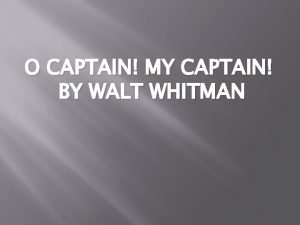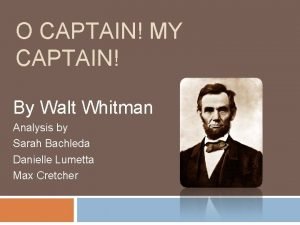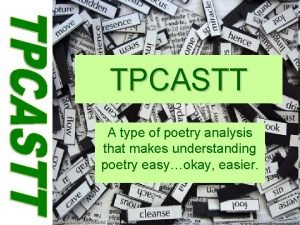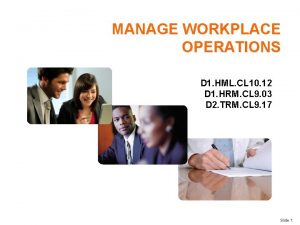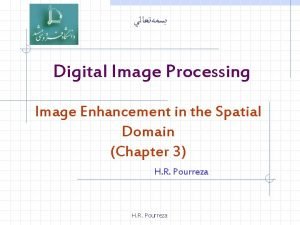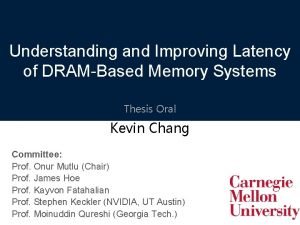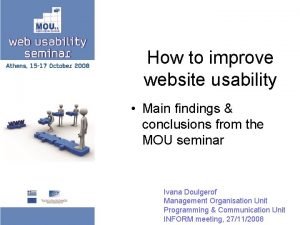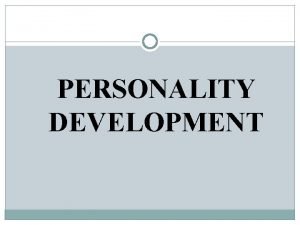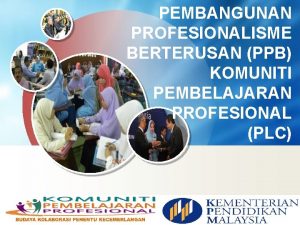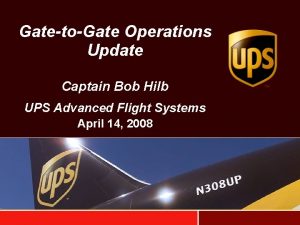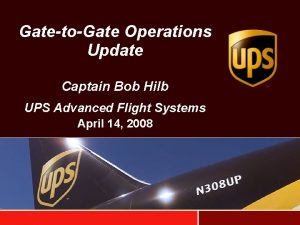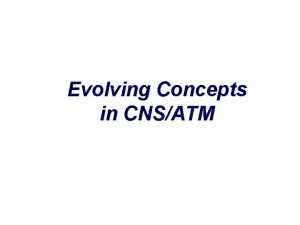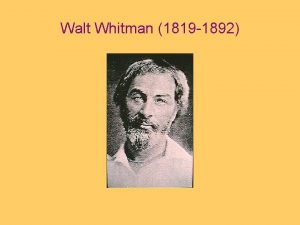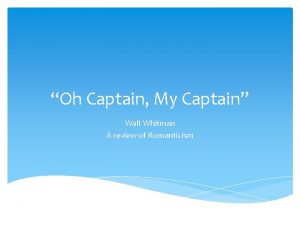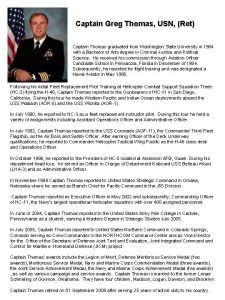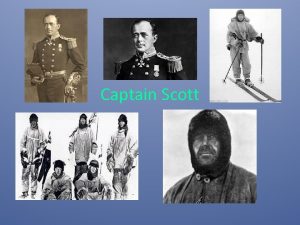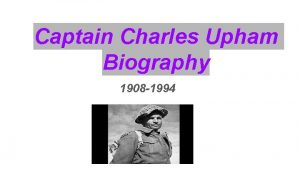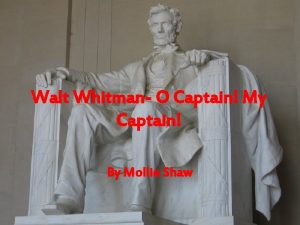Using CNSATM to Dramatically Improve GatetoGate Operations Captain






















- Slides: 22

Using CNS/ATM to Dramatically Improve Gate-to-Gate Operations Captain Bob Hilb UPS Advanced Flight Systems October 8, 2007

Agenda • Modernization • Background • Gate-to-Gate Scheduling and Control • Merging and Spacing • Surface Area Movement Management • Benefits 2

Aviation Modernization • Current operations are very unpredictable – Lacking complete surveillance, real scheduling and control are not realistic • Gate-to-Gate surveillance, RTA to enable airborne spacing, Next. Gen CDA RNAV/RNP procedures, and datalink enable controlling of a total schedule • Merging and Spacing can deliver aircraft to the runway, the critical point of the schedule, within a few seconds – Result is dramatic increases in capacity and efficiency in addition to environmental benefits – Time based wake turbulence separation can enable all weather capacity consistency – Can be done with minimal FMS and ATC automation changes 3

Modernization Strategy • Requires new shared surveillance system – Enables capacity, efficiency, security, environmental improvements, and gate-to-gate transparency and control • Requires Air Traffic Management instead of Control – Scheduling and maintaining the schedule at a strategic level • Requires move to aircraft centric spacing to maintain the schedule at a tactical level • Requires incremental, pragmatic steps toward the end state with affordable retrofit 4

Louisville Technology Demonstration • New terminal area automation system • New surface surveillance system • Surface Management System (SMS) • ADS-B Cockpit Display of Traffic Information (CDTI) on 107 B-757 and B-767 aircraft – ADS -B “out” on other aircraft • Successful test of Continuous Descent Arrivals (CDAs) • Airline Based En Route Sequencing and Spacing (ABESS) tool 5

SMS – Airport View 6

Continuous Descent Arrivals • Arrival procedure (RNAV/RNP) for idle power descent from cruise to final approach – saves fuel, lowers noise, lowers emissions • FAA Center of Excellence for Noise & Emissions sponsored successful trials Oct. 2004 at SDF 7

Trial Results Reduced Noise Impact CDA (Sept 14 -18) ) Baseline (Sep 28 -Oct 2) • Continuous Descent Arrivals – October 2004 Trials – 30% reduction in noise (up to 6 d. B) – 34% reduction in nitrous oxide (NOx) emissions – Below 3000 feet – 250 to 465 pounds less fuel burn per flight 8

Trial Results • Identified the need for a closed loop spacing system for high traffic density Next. Gen CDAs • Needs affordable retrofit to make the concept feasible – Bundled applications in an Electronic Flight Bag – Merging and Spacing – Surface Area Movement Management – ATC datalink and others – Surveillance Processor alternative to FMS upgrade – Merging and Spacing with RTA 9

ABESS • Based on earlier MITRE and NASA work • Uses all available surveillance sources to predict aircraft sequence and build schedule for arrival fix (at all runway ends – future) – FAA radars, ACARS, ADS-B, and Rapid Update Cycle (RUC) winds (SMS for all nearby airports - future) • Detects conflicts • Calculates speed changes and RTA to smooth flow • Uplinks speed to aircraft (RTA and M&S info – future) • Joint FAA, NASA, MITRE, UPS project 10

Scheduling Process • Utilize fused surveillance (with ADS-B accuracies) and SMS to allow scheduling of aircraft inbound to a hub – All aircraft within defined time horizon (1 -2 hours? ) – All airborne and pre-departure traffic – SMS predicts when aircraft at close-in airports will be ready for take-off – Schedule built to maximum capacity for each runway with slots for pre-departure aircraft – Move slots as required 11

Controlling the Schedule • Airborne aircraft are initially given speeds then RTA via datalink to achieve strategic schedule – Datalink - initially ACARS, ultimately ATC datalink – Scheduler - initially ABESS, ultimately in terminal traffic manager • Pre-departure aircraft are given take-off times to make their slots – Similar to today’s controlled take-off time process – Slots are easily moved to accommodate unexpected ground delays • Within ADS-B range, aircraft are assigned the aircraft to follow and spacing interval via datalink • Aircraft use M&S to the runway 12

Merging and Spacing Operations Today’s World • Controller provides delaying vector to merge E behind D • Queues build exponentially when bunching occurs often resulting in holding • Low altitude, dirty vectoring is the norm 13

Merging and Spacing Near Term Implementation Merging and Spacing VMC or IMC Next. Gen Constant Descent Arrival (CDA) CDTI Assisted Visual Separation (CAVS) / CEFR Approach 14

Merging and Spacing – near term • Redesigned RNAV/RNP arrivals that utilize CDA principles • AOC strategic scheduling and spacing at Louisville – Airline Operations Center (AOC) utilizes ABESS to provide speed, RTA, spacing, and aircraft-to-follow assignments to flight crew • ATC responsibilities unchanged – Responsible for separation – Intervenes, if necessary, to maintain arrival flow – Maintains awareness of AOC and flight deck spacing operations 15

Merging and Spacing Operations • Add flight deck-based spacing function – Uses CDTI and Speed Guidance – After flying Next. Gen CDA, CAVS approach can be flown • Worldwide implementation – ATC utilizes scheduling tool for all participants – Aircraft flying Next. Gen CDA require M&S functions – Runways can be designated for M&S operations in a mixed equipment environment for early implementation 16

VMC Capacity in IMC Conditions • CDTI Assisted Visual Separation (CAVS) – Provides the ability to maintain “Visual Approach” arrival rates in conditions that currently require Instrument Approaches – Initially allows loss of out the window visual during Visual Approaches – Ultimately penetrate cloud layer in basic VMC Next Step • Relieve controller of wake turbulence separation responsibility – With extremely consistent delivery of aircraft at runway using M&S 17

SAMM 18

Surface Area Movement Management (SAMM) • Airport surface map and traffic displayed on the EFB provides surface situational awareness to reduce runway incursions and traffic conflicts – Tracks the movements of own aircraft and other ground airborne traffic in the terminal area using ADS-B and Traffic Information Service-Broadcast (TIS-B) – Alerts crews of potential conflicts with traffic (future) – Alerts crews if incursion is imminent (future) • Commercial Aviation Safety Team (CAST) determined moving map with traffic over 95% effective – All other strategies less than 50% effective 19

UPS Aircraft Architecture • ACSS Surveillance (TCAS) 3000 – M&S, RTA, runway incursion alerting • ACSS Transponder upgrade – DO-260 A • Boeing Class III EFB – CDTI – ATC datalink (future) – SAMM – AOC Applications • Gables simple speed guidance display 20

Hub Benefits • Arrival Hub now has total transparency – SMS uses output from sequencing tool and ADS-B surveillance to predict gate arrival time – SMS monitors departing aircraft at gate to enable gate conflict detection – Much better control of connecting passengers, crews, etc • Total surveillance allows scheduling and control of entire system – With M&S delivering aircraft to the runway within a few seconds of plan, the system is now highly predicable except in the most extreme weather conditions • Efficiency and Capacity are greatly increased and become predictable 21

Airspace System Benefits • First major step towards aviation modernization • Affordable retro-fit, ability to standardize across all fleet types allows near term implementation • Provides guidance for new aircraft implementation • Bundled applications within in one system create layered, cumulative benefits with good ROI • Accelerates FAA, JPDO, and EUROCONTROL plans 22
 Oh captain my captain meaning
Oh captain my captain meaning O captain my captain poem analysis
O captain my captain poem analysis Oh captain my captain interpretation
Oh captain my captain interpretation O captain my captain audio
O captain my captain audio O captain my captain and elegy for j.f.k. answer key
O captain my captain and elegy for j.f.k. answer key O captain my captain tpcastt
O captain my captain tpcastt Adding an outlier can dramatically change the correlation
Adding an outlier can dramatically change the correlation Dramatically and symbolically
Dramatically and symbolically How to monitor and improve workplace operations
How to monitor and improve workplace operations How to do inverse operations
How to do inverse operations Mask mode radiography
Mask mode radiography Using system using system.collections.generic
Using system using system.collections.generic Dtfd switch
Dtfd switch Improve memory latency
Improve memory latency Improve website usability
Improve website usability Www.reachoutworld.org/amc
Www.reachoutworld.org/amc If you cannot measure it you cannot manage it
If you cannot measure it you cannot manage it Noun to verb suffix
Noun to verb suffix Freud's personality theory
Freud's personality theory Define measure improve control
Define measure improve control Action plan for listening skills
Action plan for listening skills Pelan pembelajaran profesional
Pelan pembelajaran profesional Boehm staffing principles
Boehm staffing principles
